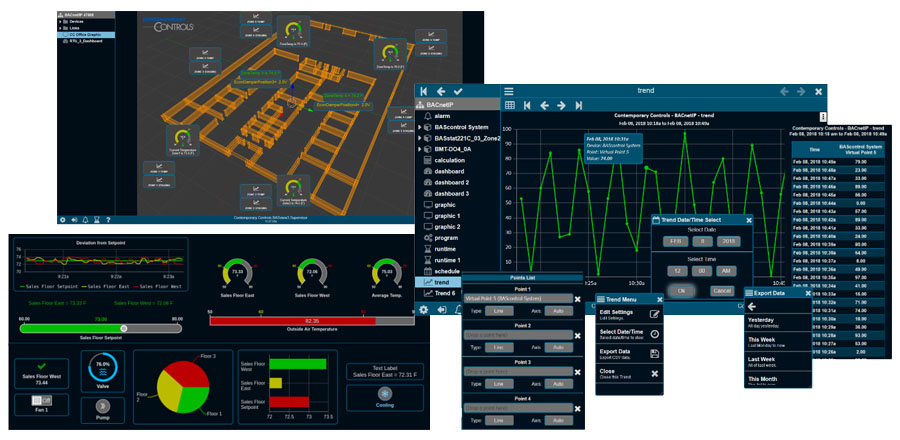Control Network Newsletter

Communicating Thermostats with BACnet Supervision Provide Warehouse Temperature Automation and Control
A warehouse added temperature automation and control with a building management system (BMS) to improve indoor climate control and energy efficiency. As Wi-Fi was not available at this facility, they replaced their stand-alone thermostats with Contemporary Controls' BACnet-compliant single-mode, wired communicating thermostats and a BACnet supervisor to provide seamless automation and control of the warehouse's unitary cooling units. If the warehouse is located in a cold climate that requires the use of unitary heaters instead, the BAST-121C thermostats can be set for heat only mode.

The warehouse utilized the configuration as shown in the image above. Our BAST-121C-B2 BACnet MS/TP Single Mode thermostats were suited for this application as they are designed for single- or multi-stage heating only or cooling only binary or analog output control applications, such as the direct expansion (DX) cooling units used within the warehouse. Our BASview3 Supervisor is a stand-alone, embedded, web-based graphical interface that provides BACnet/IP client functionality and control in one package.
The BAST-121C-B2 thermostat is connected to BACnet MS/TP using an EIA-485 serial connection. With a 1200 m/4000 ft maximum segment distance, the EIA-485 physical layer offers flexibility and convenience, allowing to thermostats to be easily networked together in a daisy chain with a single-pair cable. The EIA-485 physical layer offers the flexibility and convenience of a maximum segment distance of up to 1200 m/4000 ft. Communicating at lower speeds makes it more resilient to the noise present in commercial and industrial environments. EIA-485 wiring can be found in many existing buildings making it ideal for retrofit upgrades without the need to run new wires.
The BASview3 communicates to the thermostats using the BACnet/IP protocol over a wired Ethernet connection. Therefore, a BACnet MS/TP to BACnet/IP router is required to integrate the thermostat to the BASview3 supervisor. The BASRT-B router converts the BACnet MS/TP serial connection from several (up to 32) BAST-121C-B2 thermostats on the same bus to a wired Ethernet switch which provides BACnet/IP to the BACnet supervisor over a wired Ethernet connection.
The BASview3 is a centralized supervisory device that can discover the BACnet thermostats and their associated points. The BASview3 features animated graphics and dashboard screens that can monitor the current temperature, set up schedules with holiday exceptions, and implement schedules that vary between the warehouse zones per their different occupied times. It can collect runtime, trend, and performance data and also provides diagnostic information which can be used to set up and monitor alarm conditions and send alerts via email.

A laptop and web browser can be used to view the supervisor dashboard. A wall-mounted display, such as an Android Screen, can be connected to the network for easy access. The display unit can be mounted to a central location over Ethernet or Wi-Fi (model dependent). A display with a PoE option can supply both power and network connectivity over a single Ethernet cable.
The BAST-121C-B2 is BTL listed to ensure effortless integration BACnet MS/TP networks, and model BAST-121C-BW2 is available for locations with Wi-Fi access. A configurable and adaptive control algorithm applied to multi-stage on/off control saves energy and ensures seamless comfort for the occupants. The thermostat offers three sensing options—a built in temperature sensor, input for a remote temperature sensor, or a temperature network command from the BMS. Occupancy status can be set from thermostat buttons, a wired ESI input, or over the BACnet network.
For more information, visit the BASstat121 product page or the BASview3 product page.